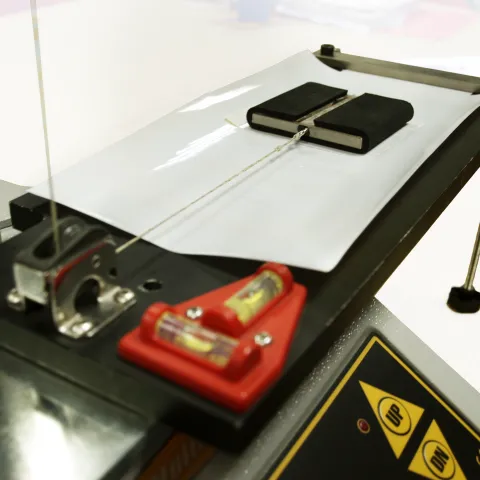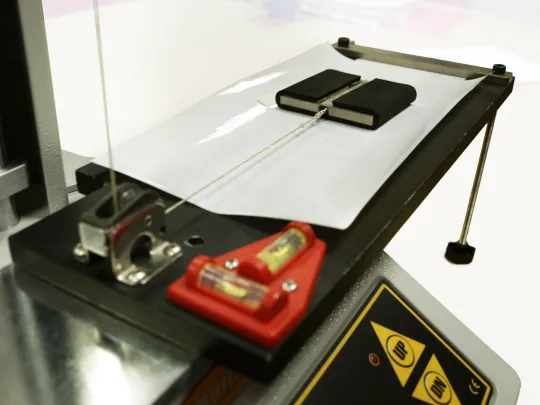Test summary
Test standard BS EN ISO 8295 enables the calculation of the static and kinetic (dynamic) coefficient of friction, µ, between two surfaces. This standard is applicable to plastic films and sheets, defined as non-sticky and up to 0.5 mm thick. The effects of surface finishes or preparations involving inks (blocking), embossing or lithography processes on printed materials, surfaces (e.g. flooring), labelling, packaging and enclosure products can be measured
Test apparatus
Horizontal test table, non-ferromagnetic metal.
Sled (200 ± 2 g), to generate the normal force (1.96 ± 0.02 N). Base covered in elastic material, e.g. felt.
A driving mechanism to produce a relative motion between the sled and the test table, regardless of which is the moving part.
A force measurement system where the pulling direction shall be in straight alignment with the frictional plane.
Flexible link to the sled is recommended for the static friction measurement.
Preparation
The standard indicates two test pieces, one of approximately 80 x 200 mm is laid upon the table and secured. The size of upper test piece is the size of the sled contact area of 63 mm x 63 mm.
At least three such pairs of test specimens taken from points uniformly distributed over the width of the sample, or the circumference in the case of tubular film, shall be tested.
Unless otherwise specified, the long axis, and thus the test direction, shall be parallel to the machine direction of the film. When different frictional properties are expected for the two surfaces, they should be clearly identified. E.g., for front (1) and back (2), the two surfaces may be identified as 1/1, 2/2 and/or 1/2.
Extreme care must be taken when handling the samples to avoid contamination. Several specimens may be cut simultaneously and separated immediately before testing.
Unless otherwise specified, specimens shall be conditioned for at least 16 h in standard atmosphere 23/50 (temperature/humidity) as defined in ISO 291
Test method
The time for which these surfaces are in contact influences the static friction characteristics, so this time should be specified for comparable quality control testing.
The test speed is 100 ± 10 mm/min, in the case of specialist films or where difficulties encountered, a speed of 500 ± 10 mm/min may be used.
For dynamic friction measurement, at least 6 cm of movement is required over which to average the force. This calculation should neglect the static force peak.
To test film against film:
Fix the lower test specimen to the table with the clamp at one end and the other with adhesive tape.
Attach the second test piece to the sled.
Rest for 15 seconds.
Start the motion of the sled, the first peak is caused by the static friction.
Continuing movement will record the force due to kinetic friction, in the absence of stick-slip. Continue for at least 6 cm and determine the average force.
To test film in contact with metal or another material, replace the lower test specimen with the material in question.
Calculate the coefficient of friction from the formula: µ = F/mg, where mg is the sled weight and the force value is averaged over the six tests

